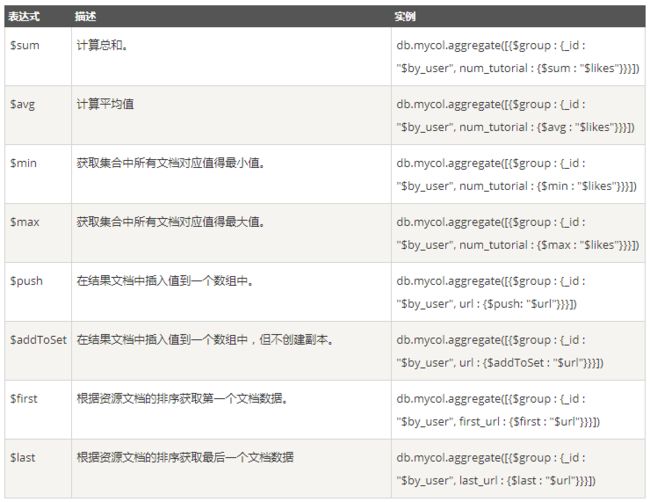Mongoose: aggregate() 方法实现聚合函数
原载于 https://szhshp.org/tech/2019/09/07/mongodbaggregatefunc.html, 转载请注明
需求描述
首先我有一个 Item 的 collection:
type Item {
_id: String
itemname: String!
itemid: String!
itemtype: String!
parent_id: String
}
///////////////////
/// 主要是下面这一些部分
type Query {
getItemSummary: ItemSummaryResponse
}
type ItemSummaryResponse {
data: [ItemSummary]
success: Boolean
}
type ItemSummary {
_id: String
count: Int
}
gql 端调用的方法:
{
getItemSummary {
data{
_id
count
}
success
}
}
然按照其中的类别 (itemtype) 进行总计:
那么实际上在后台 mongoose 里面需要这么写:
getItemSummary: root => Item.aggregate([{
$group: {
_id: '$itemtype',
count: {
$sum: 1,
},
},
}, ]).then((res) => {
if (res === null) {
return {
success: 0,
errors: ['sadfsdfsdf']
};
}
return ({
success: 1,
errors: [],
data: res,
});
}),
聚合函数 aggregate() 的使用
首先写明按照哪个 field 进行聚合
$group: {
_id: '$itemtype',
// 这个地方比较重要,首先左边一定要写成 _id, 最后在前端通过 gql 取的时候也是写 _id
// 另外重要是这个 key 的值是 $itemtype, 说明根据 itemtype 进行 group, 直接写 $ + fieldname 即可
count: {
$sum: 1,
},
},
因为 $group 里面对应需要聚合操作的列必须写成 _id , 否则会出现 The field 'xxx' must be an accumulator object 的报错信息
另外 SQL 的聚合函数都可以用到这里:
聚合管道
管道在 Unix 和 Linux 中一般用于将当前命令的输出结果作为下一个命令的参数。
基本上就是逐个执行聚合方法里面的方法.
上方的聚合函数仅仅执行了对一个 field 的聚合:
Item.aggregate([{
$group: {
_id: '$itemtype',
count: {
$sum: 1
}
}
}, ])
但是实际上可以在这些操作之前之后加更多的操作.
比如想要将,70 分到 90 分之间的数据先筛选出来再进行 group:
db.articles.aggregate([{
$match: {
score: {
$gt: 70,
$lte: 90
}
}
},
{
$group: {
_id: null,
count: {
$sum: 1
}
}
}
]);
常用的几个操作
- $project:修改输入文档的结构。可以用来重命名、增加或删除域,也可以用于创建计算结果以及嵌套文档。
- $match:用于过滤数据,只输出符合条件的文档。使用 MongoDB 的标准查询操作。
- $limit:用来限制 MongoDB 聚合管道返回的文档数。
- $skip:在聚合管道中跳过指定数量的文档,并返回余下的文档。
- $unwind:将文档中的某一个数组类型字段拆分成多条,每条包含数组中的一个值。
- $group:将集合中的文档分组,可用于统计结果。
- $sort:将输入文档排序后输出。
- $geoNear:输出接近某一地理位置的有序文档。
实例
$project 实例
0 为不显示,1 为显示,默认情况下 _id 字段是 1
db.articles.aggregate({
$project: {
_id: 0,
title: 1,
by_user: 1,
}
});
// 返回
{ "title" : "MongoDB Overview", "by_user" : "runoob.com" }
{ "title" : "NoSQL Overview", "by_user" : "runoob.com" }
{ "title" : "Neo4j Overview", "by_user" : "Neo4j" }
$match 实例
m a t c h 用 于 获 取 分 数 大 于 70 小 于 或 等 于 90 记 录 , 然 后 将 符 合 条 件 的 记 录 送 到 下 一 阶 段 match 用于获取分数大于 70 小于或等于 90 记录,然后将符合条件的记录送到下一阶段 match用于获取分数大于70小于或等于90记录,然后将符合条件的记录送到下一阶段group 管道操作符进行处理。
db.articles.aggregate([{
$match: {
score: {
$gt: 70,
$lte: 90
}
}
},
{
$group: {
_id: null,
count: {
$sum: 1
}
}
}
]);
// 返回
{ "_id" : null, "count" : 1 }
$skip 实例
经过 $skip 管道操作符处理后,前 2 个文档被"过滤"掉。
db.col_1.aggregate({ $skip: 2 });
参考文献
https://www.jianshu.com/p/baea1bce6de3
